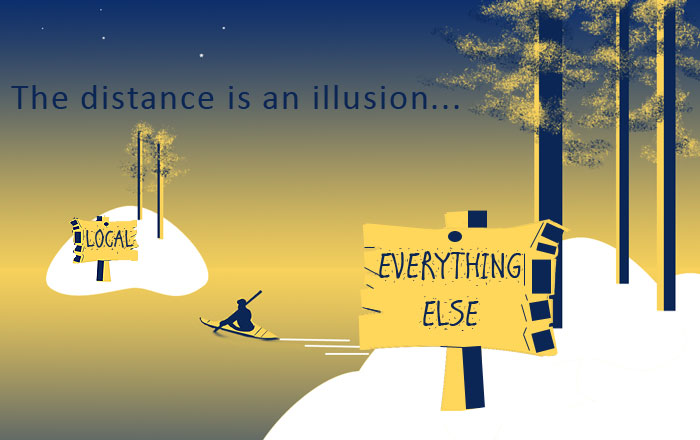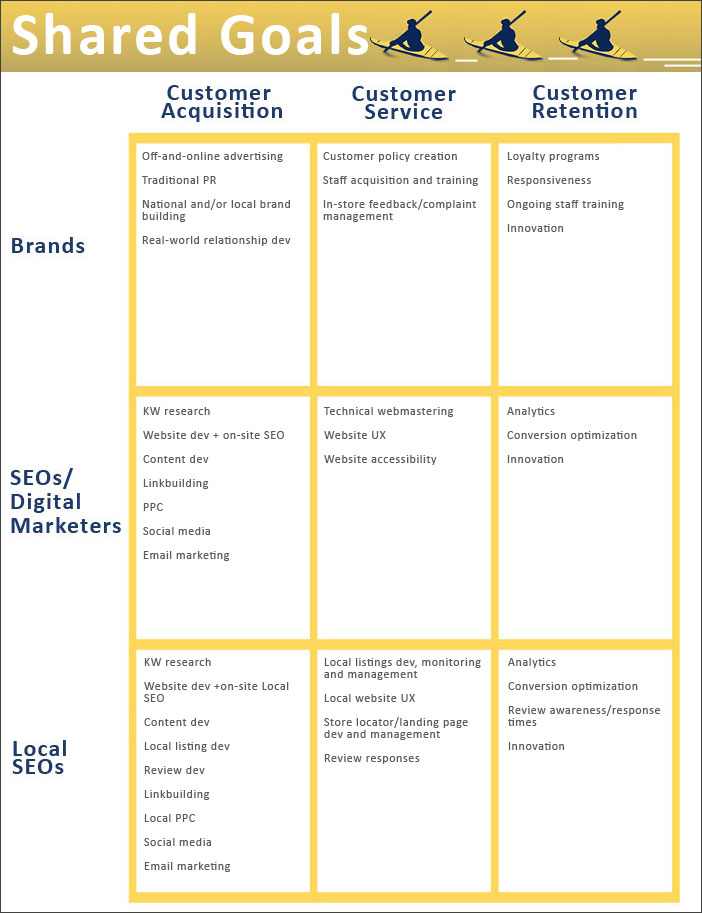Posted by MiriamEllis

You own, work for, or market a business, but you don’t think of yourself as a Local SEO.
That’s okay. The forces of history have, in fact, conspired in some weird ways to make local search seem like an island unto itself. Out there, beyond the horizon, there may be technicians puzzling out NAP, citations, owner responses, duplicate listings, store locator widgets and the like, but it doesn’t seem like they’re talking about your job at all.
And that’s the problem.
If I could offer you a seat in my kayak, I’d paddle us over to that misty isle, and we’d go ashore. After we’d walked around a bit, talking to the locals, it would hit you that the language barrier you’d once perceived is a mere illusion, as is the distance between you.
By sunset — whoa! Look around again. This is no island. You and the Local SEOs are all mainlanders, reaching towards identical goals of customer acquisition, service, and retention via an exceedingly enriched and enriching skill set. You can use it all.
Before I paddle off into the darkness, under the rising stars, I’d like to leave you a chart that plots out how Local SEO fits in with everything you’ve been doing all along.
The roots of the divide
Why is Local SEO often treated as separate from the rest of marketing? We can narrow this down to three contributing factors:
1) Early separation of the local and organic algos
Google’s early-days local product was governed by an algorithm that was much more distinct from their organic algorithm than it is today. It was once extremely common, for example, for businesses without websites to rank well locally. This didn’t do much to form clear bridges between the offline, organic, and local marketing worlds. But, then came Google’s Pigeon Update in 2013, which signaled Google’s stated intention of deeply tying the two algorithms together.
This should ultimately impact the way industry publications, SaaS companies, and agencies present local as an extension of organic SEO, but we’re not quite there yet. I continue to encounter examples of large companies which are doing an amazing job with their website strategies, their e-commerce solutions and their paid outreach, but which are only now taking their first steps into local listings management for their hundreds of physical locations. It’s not that they’re late to the party — it’s just that they’ve only recently begun to realize what a large party their customers are having with their brands’ location data layers on the web.
2) Inheriting the paid vs. organic dichotomy
Local SEO has experienced the same lack-of-adoption/awareness as organic SEO. Agencies have long fought the uphill battle against a lopsided dependence on paid advertising. This phenomenon is highlighted by historic stats like these showing brands investing some $10 million in PPC vs. $1 million in SEO, despite studies like this one which show PPC earning less than 10% of clicks in search.
My take on this is that the transition from traditional offline paid advertising to its online analog was initially easier for many brands to get their heads around. And there have been ongoing challenges in proving direct ROI from SEO in the simple terms a PPC campaign can provide. To this day, we’re still all seeing statistics like only 17% of small businesses investing in SEO. In many ways, the SEO conundrum has simply been inherited by every Local SEO.
3) A lot to take in and on
Look at the service menu of any full-service digital marketing agency and you’ll see just how far it’s had to stretch over the past couple of decades to encompass an ever-expanding range of publicity opportunities:
- Technical website audits
- On-site optimization
- Linkbuilding
- Keyword research
- Content dev and promotion
- Brand building
- Social media marketing
- PPC management
- UX audits
- Conversion optimization
- Etc.
Is it any wonder that agencies feel spread a bit too thin when considering how to support yet further needs and disciplines? How do you find the bandwidth, and the experts, to be able to offer:
- Ongoing citation management
- Local on-site SEO
- Local landing page dev
- Store locator SEO
- Review management
- Local brand building
- Local link building
- And abstruse forms of local Schema implementation…
And while many agencies have met the challenge by forming smart, strategic partnerships with providers specializing in Local SEO solutions, the agency is still then tasked with understanding how Local fits in with everything else they’re doing, and then explaining this to clients. At the multi-location and enterprise level, even amongst the best-known brands, high-level staffers may have no idea what it is the folks in the in-house Local SEO department are actually doing, or why their work matters.
To tie it all together … that’s what we need to do here. With a shared vision of how all practitioners are working on consumer-centric outreach, we can really get somewhere. Let’s plot this out, together:
Sharing is caring
“We see our customers as invited guests to a party, and we are the hosts. It’s our job every day to make every important aspect of the customer experience a little bit better.”
– Jeff Bezos, Amazon
Let’s imagine a sporting goods brand, established in 1979, that’s grown to 400 locations across the US while also becoming well-known for its e-commerce presence. Whether aspects of marketing are being outsourced or it’s all in-house, here is how 3 shared consumer-centric goals unify all parties.

As we can see from the above chart, there is definitely an overlap of techniques, particularly between SEOs and Local SEOs. Yet overall, it’s not the language or tactics, but the end game and end goals that unify all parties. Viewed properly, consumers are what make all marketing a true team effort.
Before I buy that kayak…
On my commute, I hear a radio ad promoting a holiday sale at some sporting goods store, but which brand was it?
Then I turn to the Internet to research kayak brands, and I find your website’s nicely researched, written, and optimized article comparing the best models in 2017. It’s ranking #2 organically. Those Sun Dolphins look pretty good, according to your massive comparison chart.
I think about it for a couple of days and go looking again, and I see your Adwords spot advertising your 30% off sale. This is the third time I’ve encountered your brand.
On my day off, I’m doing a local search for your brand, which has impressed me so far. I’m ready to look at these kayaks in person. Thanks to the fact that you properly managed your recent move across town by updating all of your major citations, I’m finding an accurate address on your Google My Business listing. Your reviews are mighty favorable, too. They keep mentioning how knowledgeable the staff is at your location nearest me.
And that turns out to be true. At first, I’m disappointed that I don’t see any Sun Dolphins on your shelves — your website comparison chart spoke well of them. As a sales associate approaches me, I notice in-store signage above his head, featuring a text/phone hotline for complaints. I don’t really have a complaint… not yet… but it’s good to know you care.
“I’m so sorry. We just sold out of Sun Dolphins this morning. But we can have one delivered to you within 3 days. We have in-store pickup, too,” the salesperson says. “Or, maybe you’d be interested in another model with comparable features. Let me show you.”
Turns out, your staffer isn’t just helpful — his training has made him so well-versed in your product line that he’s able to match my needs to a perfect kayak for me. I end up buying an Intex on the spot.
The cashier double-checks with me that I’ve found everything satisfactory and lets me know your brand takes feedback very seriously. She says my review would be valued, and my receipt invites me to read your reviews on Google, Yelp, and Facebook… and offers a special deal for signing up for your email newsletter.
My subsequent 5-star review signals to all departments of your company that a company-wide goal was met. Over the next year, my glowing review also influences 20 of my local neighbors to choose you over a competitor.
After my first wet, cold, and exciting kayaking trip, I realize I need to invest in a better waterproof jacket for next time. Your email newsletter hits my inbox at just the right time, announcing your Fourth of July sale. I’m about to become a repeat customer… worth up to 10x the value of my first purchase.
“No matter how brilliant your mind or strategy, if you’re playing a solo game, you’ll always lose out to a team.”
– Reid Hoffman, Co-Founder of LinkedIn
There’s a kind of magic in this adventurous mix of marketing wins. Subtract anything from the picture, and you may miss out on the customer. It’s been said that great teams beat with a single heart. The secret lies in seeing every marketing discipline and practitioner as part of your team, doing what your brand has been doing all along: working with dedication to acquire, serve and retain consumers. Whether achievement comes via citation management, conversion optimization, or a write-up in the New York Times, the end goal is identical.
It’s also long been said that the race is to the swift. Media mogul Rupert Murdoch appears to agree, stating that, in today’s world, it’s not big that beats small — it’s fast that beats slow. How quickly your brand is able to integrate all forms of on-and-offline marketing into its core strategy, leaving no team as an island, may well be what writes your future.
Sign up for The Moz Top 10, a semimonthly mailer updating you on the top ten hottest pieces of SEO news, tips, and rad links uncovered by the Moz team. Think of it as your exclusive digest of stuff you don’t have time to hunt down but want to read!
![]()
